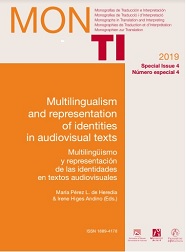Conversation as a unit of film analysis. Databases of L3 translation and audiovisual samples of multilingualism
Main Article Content
Abstract
Downloads
Article Details
The documents contained in these directories are included by the contributing authors as a means to ensure timely dissemination of scholarly and technical work on a non-commercial basis. It is understood that all persons copying this information will adhere to the terms and constraints invoked by each author's copyright. These works may not be reposted without the explicit permission of the copyright holder.
References
Bakhtin, Mikhail. (1982) The Dialogic Imagination: Four Essays. Austin, TX:University of Texas Press Slavic Series.
Bakhtin, Mikhail. (1986) Speech Genres and Other Late Essays. Cited in the English translation by Vern W. McGee. Austin, TX: University of Texas Press.
Baldry, Anthony. (2016) “Multisemiotic Transcriptions as Film Referencing Systems.” In: Taylor, C. (ed.) 2016. A Text of Many Colours – Translating The West Wing. inTralinea Translation Journal. Special Issue. Electronic versión available at: http://www.intralinea.org/specials/article/2195
Bleichenbacher, Lukas. (2008) Multilingualism in the Movies. Hollywood Characters and their Language Choices. Tübingen: Francke.
Bordwell, David. (2006) The Way Hollywood Tells It - Story and Style in Modern Movies. Berkeley: University of California Press.
Bucholtz, Mary & Kira Hall. (2004) “Language and Identity.” In: Duranti, Alessandro (ed.) 2004. A Companion to Linguistic Anthropology. Oxford: Blackwell Publishing Ltd., pp. 369-394.
Chaume, Frederic. (2004) Cine y traducción. Madrid: Cátedra.
Corrius, Montse. (2008) Translating Multilingual Audiovisual Texts. Priorities and Restrictions. Implications and Applications. Barcelona: Universitat Autònoma de Barcelona. Unpublished Ph.D. Thesis.
Corrius, Montse & Patrick Zabalbeascoa. (2011) “Language Variation in Source Texts and their Translations.” Target 23:1, pp. 113-130.
de Higes-Andino, Irene; Ana Maria Prats-Rodríguez; Juan José Martínez-Sierra & Frederic Chaume. (2013) “Subtitling Language Diversity in Spanish Immigration Films.” Meta 58:1, pp.134-145.
de Higes-Andino, Irene. (2014) “The translation of multilingual films: Modes, strategies, constraints and the manipulation in the Spanish translations of It’s a Free World…” Linguistica Antverpiensia, New series. Themes in Translation Studies 13, pp. 211-231.
Delabastita, Dirk & Rainer Grutman (eds.) (2005) “Fictionalising Translation and Multilingualism.” Linguistica Antverpiersa. New Series. Themes in Translation Studies 4, pp. 11-34.
Di Giovani, Elena. (2003) “Cultural Otherness and Global Communication in Walt Disney Films at the Turn of the Century.” The Translator 9:2, pp. 207-223.
Díaz-Cintas, Jorge. (2014) “Multilingüismo, traducción audiovisual y estereotipos: el caso de Vicky Cristina Barcelona.” Prosopopeya. Revista de Crítica contemporánea: traducción, ideología y poder en la ficción audiovisual 9, pp.135-164.
Dwyer, Tessa. (2005) “Universally speaking: Lost in Translation and polyglot cinema.” Linguistica Antverpiensia, New Series-Themes in Translation Studies 4, pp. 295-310.
Fuller, Graham. (1998) Loach on Loach. London: Faber and Faber Ltd.
Goffman, Ervin. (1957) “Alienation from interaction.” Human Relations 10, pp. 47-60.
Grice, H. Paul. (1975) “Logic and Conversation”. In: Cole, Peter and Jerry L. Morgan (eds.) 1975. Syntax and Semantics, 3, Speech Acts. New York: Academic Press, pp. 41–58.
Grice, H. Paul. (1989) Studies in the Way of Words. Cambridge, MA: Harvard University Press.
Hatim, Basil & Ian Mason. (2000) “Politeness in Screen Translating.” In: Venuti, Lawrence (ed.) 2000. The Translation Studies Reader. London: Routledge, pp. 430-446.
Heiss, Christine. (2004) “Dubbing multilingual films: A new challenge?” Meta 49:1, pp. 208-220.
Iberg, Sofia. (forthcoming 2018) “A game of languages: The use of subtitles for invented languages in TV series.” In: Ranzato, Irene & Serenella Zanotti (eds.) 2018. Linguistic and Cultural Representation in Audiovisual Translation. London: Routledge.
Konigsberg, Ira. (1993) The Complete Film Dictionary. London: Bloomsbury.
Krämer, Mathias & Eva Eppler. (forthcoming 2018) “The deliberate non-subtitling of L3s in a multilingual TV series: the example of Breaking Bad.” Meta 63:2.
Kuhn, Annette & Guy Westwell. (2012) Oxford Dictionary of Film Studies. Oxford: Oxford University Press.
Mason, Ian. (2005) “Projected and Perceived Identities in Dialogue Interpreting.” In: House, Juliane; Rosario Martín Ruano & Nicole Baumgarten (eds.) 2005. Translation and the Construction of Identity. IATIS 2005, pp. 30-52.
Martínez-Sierra, Juan José; José Luis Martí-Ferriol; Irene de Higes-Andino; Ana M. Prats-Rodríguez & Frederic Chaume. (2010) “Linguistic Diversity in Spanish Immigration Films. A Translational Approach.” In: Berger, Verena & Miya Komori (eds.) Polyglot Cinema. Vienna: Lit Verlag, pp. 15-29.
Metz, Christian. (1974) Language and Cinema. Berlin: Walter de Gruyter.
Meylaerts, Reine & Adriana Şerban. (2014) “Multilingualism at the cinema and on Stage: A translation perspective.” Linguistica Antverpiensia. New Series. Themes in Translation Studies 13, pp.1-13.
O’Sullivan, Carol. (2011) Translating Popular Film. Basingstoke: Palgrave Macmillan Ltd.
Raskin, Victor. (1987) “Linguistic heuristics of humor: A script-based semantic approach.” In: Apte, Mahadev (eds.) Language and Humor, a special issue of The International Journal of the Sociology of Language 65:3, pp 11-25.
Santamaria, Laura. (2001) Les referències culturals: aportació informativa i valor expressiu. El subtitulat. Barcelona: Universitat Autònoma de Barcelona. Unpublished Ph.D. Thesis.
Sidnell, Jack. (2010) Conversation Analysis: An Introduction. Chichester: Wiley-Blackwell.
Wahl, Chris. (2005) “Discovering a genre: the polyglot film.” Cinemascope,Independent Film Journal 1, pp. 1-8.
Zabalbeascoa, Patrick & Elena Voellmer. (2015) “La traducción de textos audiovisuales polilingües.” In: Rentel, Nadine; Ursula Reutner & Ramona Schröpf (eds.) 2015. Lingüística mediática y traducción audiovisual. Bern: Peter Lang, pp. 71-92.
Zabalbeascoa, Patrick & Stavroula Sokoli. (2017) The Trafilm Guide. UPF Digital Repository. Electronic version available at: http://hdl.handle.net/10230/28223
Zhang, Xiaochun. (2015) “Cinematic Multilingualism in China and its Subtitling.” Quaderns Revista de Traducció 22, pp. 385-398.
Online Resources:
Imdb, Blade Runner (1982). URL: http://www.imdb.com/title/tt0083658/trivia
Filmography:
A Passage to India (David Lean 1984)
An American in Paris (Vincente Minnelli 1951)
Babel (Alejandro González Iñárritu 2006)
Blade Runner (Ridley Scott 1982)
Beauty and the Beast (Gary Trousdale & Kirk Wise 1991)
Bread and Roses (Ken Loach 2000)


